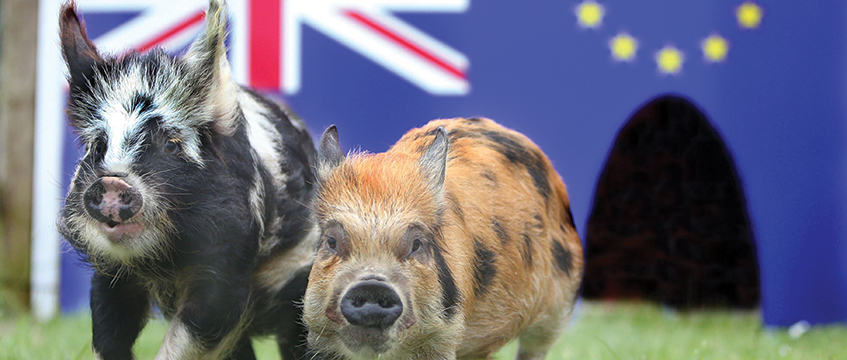The seasons march on while Brexit lies marooned. These are difficult times for farmers and their advisers, with only the flimsiest idea of the terms on which this year’s harvest may be sold over the forthcoming winter. Yet plans will soon need to be made for the next planting season without knowing the terms of trade with the rest of the EU or the rest of the world.
The state of the industry
The government’s annual report on agriculture in the UK (Defra: Agriculture in the United Kingdom, 2018) shows the overwhelming importance of international trade to the farming industry. The value of food and drink exports was £22bn (£4.5bn of this is whisky) and imports was £46.2bn (fresh fruit and vegetables were £6.2bn of this). There was an export deficit for food and drink of £24.2bn but even allowing for this, export markets are clearly very important for a lot of UK farmers. The top 10 countries for our exports include only three that are not in the EU 27 (the USA, China and Hong Kong are in third, eighth and 10th positions respectively) and the top 10 points of origin for our imports include only the USA (in 10th position) outside the EU 27.
The terms on which we will trade with these countries after Brexit is not yet known. In at least one scenario there will be very modest or virtually negligible tariffs on food imports, while exports could face significantly higher tariffs. Tariff rates are only part of the story – other rules will need to be agreed about the rules for preservation and transportation of food. The chlorination of US chickens is just one small part of this story.
Against this background, farmers could be forgiven for emulating the ostrich: sticking their heads in the sand until it is all over. But if there is little that an individual farmer can do to influence the wider economic movements, there remains much that can be addressed at home.
Farm economic performance
The latest Farm Business Survey shows the continuing gap in economic performance between the best and the rest. Take cereal farms, for example. The results from the survey show an average net profit of £349.30 per ha, but the top 25% of performers in the survey are clearing £578.90. Given that this includes subsidy income of about £250 per ha, it becomes clear that the income of the better performers is better insulated against economic shock than the average. Detailed analysis shows that there is no single point of difference between the best and the rest – the better performers have slightly higher margins over their direct costs and considerably lower overheads.
Other sectors show the same characteristics. In dairy the difference is even more pronounced. Net profit of £1,530 per ha for the top performers compares with only £837.40 per ha for the average players. Take away the subsidy of £200-£250 per ha from these figures and the top players are still substantially better off without subsidy than the average performers can manage with it.
However, these margins could look very different if UK export markets become restricted while imports become more liberal once farming moves out of the EU’s protective embrace.
Crisis in the hills
The hill areas deserve special mention. Up in the hills even the top performers will struggle without subsidies, with profit of £310.20 per ha becoming a loss of £80.20 without direct government support. The main enterprises on these hills will be sheep and cattle. The trade figures for lamb and mutton show that we exported 89,000 tonnes in 2017 and imported 80,000 tonnes. France is a valuable export market for sheep farmers. Will there be a future for the sheep on our hills? Beef and veal are better placed, with imports of 273,000 tonnes against exports of 107,000 tonnes.
What does a hill farmer do if subsidies are reduced, withdrawn or redirected, and the export market for his main product collapses? There might be some hope that the redirection of subsidy funding towards public money for public goods will help but belt-tightening can only go so far. Land abandonment perhaps? Tree planting? Given the lack of clarity on the outlook for any of this, the prospects in our more marginal agricultural areas seem very sombre indeed.
Rental prospects
Invariably, the economic condition of agriculture has knock-on effects on the supply industries, rural employment and landlord and tenant matters. There only seems to be one direction for future rent reviews as farm profits are likely to be squeezed, but the larger question for some landowners may even be to ask if they will be able to let their land at all? This is a familiar question to commercial property investors, but one that has not been raised seriously with regard to agricultural land since the 1930s.
Despite this uncertain outlook some commentators have suggested that this could be a great opportunity for British agriculture. Whatever the merits of this argument, it is clear that the better the performance of the existing farm business the better its prospects of continuing success under whatever shape the new regime takes. The message for landlords must be clear: identify your winners, cultivate them carefully, take a wide view on future business directions with a flexible approach to tenancy terms. This is not a time to be bound by some of the more traditional straightjackets of the landlord and tenant relationship. The development of alternative scenarios could also be useful given the prevailing uncertainty – an approach pioneered so successfully by Shell in the run-up to the oil crisis of the 1970s.
Remarkably the Agriculture and Horticulture Development Board reports that many of the poorest performing farmers in the country have little idea of their relative position because they don’t benchmark their performance. Time to take stock.








